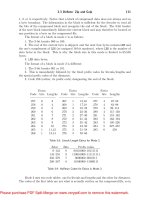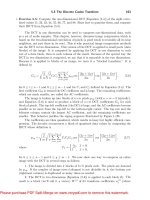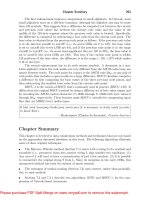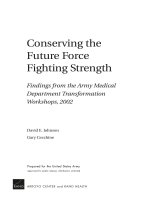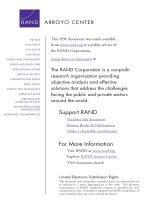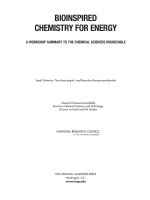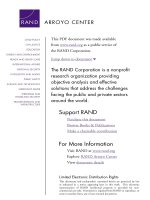The Weapons Mix Problem - A Math Model to Quantify the Effects of Internetting of Fires to the Future Force pptx
Bạn đang xem bản rút gọn của tài liệu. Xem và tải ngay bản đầy đủ của tài liệu tại đây (1.22 MB, 48 trang )
This PDF document was made available from www.rand.org as a public
service of the RAND Corporation.
6
Jump down to document
This document and trademark(s) contained herein are protected by law as indicated in a notice
appearing later in this work. This electronic representation of RAND intellectual property is provided
for non-commercial use only. Permission is required from RAND to reproduce, or reuse in another
form, any of our research documents for commercial use.
Limited Electronic Distribution Rights
CHILD POLICY
CIVIL JUSTICE
EDUCATION
ENERGY AND ENVIRONMENT
HEALTH AND HEALTH CARE
INTERNATIONAL AFFAIRS
NATIONAL SECURITY
POPULATION AND AGING
PUBLIC SAFETY
SCIENCE AND TECHNOLOGY
SUBSTANCE ABUSE
TERRORISM AND
HOMELAND SECURITY
TRANSPORTATION AND
INFRASTRUCTURE
The RAND Corporation is a nonprofit research
organization providing objective analysis and effective
solutions that address the challenges facing the public
and private sectors around the world.
Visit RAND at www.rand.org
Explore RAND Arroyo Center
View document details
For More Information
Purchase this document
Browse Books & Publications
Make a charitable contribution
Support RAND
This product is part of the RAND Corporation technical report series. Reports may
include research findings on a specific topic that is limited in scope; present discus-
sions of the methodology employed in research; provide literature reviews, survey
instruments, modeling exercises, guidelines for practitioners and research profes-
sionals, and supporting documentation; or deliver preliminary findings. All RAND
reports undergo rigorous peer review to ensure that they meet high standards for re-
search quality and objectivity.
The Weapons
Mix Problem
A Math Model to Quantify the
Effects of Internetting of Fires to
the Future Force
Christopher G. Pernin, Louis R. Moore
Prepared for the United States Army
Approved for public release; distribution unlimited
The RAND Corporation is a nonprofit research organization providing objective analysis
and effective solutions that address the challenges facing the public and private sectors
around the world. RAND’s publications do not necessarily reflect the opinions of its research
clients and sponsors.
R
®
is a registered trademark.
© Copyright 2005 RAND Corporation
All rights reserved. No part of this book may be reproduced in any form by any electronic or
mechanical means (including photocopying, recording, or information storage and retrieval)
without permission in writing from RAND.
Published 2005 by the RAND Corporation
1776 Main Street, P.O. Box 2138, Santa Monica, CA 90407-2138
1200 South Hayes Street, Arlington, VA 22202-5050
201 North Craig Street, Suite 202, Pittsburgh, PA 15213-1516
RAND URL: />To order RAND documents or to obtain additional information, contact
Distribution Services: Telephone: (310) 451-7002;
Fax: (310) 451-6915; Email:
ISBN: 0-8330-3781-1
The research described in this report was sponsored by the United States Army under
Contract No. DASW01-01-C-0003.
iii
Preface
Network Centric Warfare, the new paradigm of future warfighting, will produce increased
amounts of information, and new tools will be needed to better utilize that information.
With the increase in the flows of information, decisionmaking tools and processes from the
strategic to the tactical level will allow force elements to be used more effectively during a
campaign. Understanding the appropriate mixes of effects-generating capabilities necessary to
provide a given measure of outcome—and how these capabilities might be employed in the
network-centric future—is the driver for the work on internetting of fires (IOF). Simply put,
IOF is “the ability to engage a particular target using any number of potential firers who are
able to engage due to being on the network which provides targeting information.”[1]
The goal of this report is to describe a method for answering the question, How
might internetted weapons be best employed? Additionally, this study provided a better un-
derstanding of the IOF process and a means to quantify its relationship to combat outcome.
An important aspect of implementing the IOF concept will be to discover how best
to allocate fire missions from a collection of shooters on a network. This report describes the
design and use of an analytical tool to assist in determining the allocation of weapons to tar-
gets. Proof-of-principle examples that demonstrate the model’s utility are given, along with
observations and a discussion on the way ahead for this methodology.
The tool was designed to be simple, unencumbered, and transparent, enabling the
customer to use it quickly to develop insights into weapon allocation and other aspects of
future battle command systems. This work should be of interest to those involved in C4ISR
design, development, and system acquisition planning for the Army’s Future Force.
This research was sponsored by the Director of TRADOC Analysis Center (TRAC)
and was conducted in RAND Arroyo Center’s Force Development and Technology Pro-
gram. RAND Arroyo Center, part of the RAND Corporation, is a federally funded research
and development center sponsored by the United States Army.
iv The Weapons Mix Problem: A Math Model to Quantify the Effects of Internetting of Fires to the Future Force
For more information on RAND Arroyo Center, contact the Director of Operations (tele-
phone 310-393-0411, extension 6419; FAX 310-451-6952; e-mail Marcy_Agmon@
rand.org), or visit Arroyo’s web site at />v
Contents
Preface iii
Figures
vii
Tables
ix
Summary
xi
Acknowledgments
xv
Acronyms
xvii
CHAPTER ONE
Introduction 1
Networked Fires
2
Structure of the Report
4
CHAPTER TWO
Description of Methodology 5
Problem Formulation
6
Data Input
6
Constraints
8
Origin of the Input Data
8
Calculating Expected Kills
9
Limitations of the Model
10
CHAPTER THREE
Example Analysis 11
CHAPTER FOUR
Insights and Future 17
Future Improvements
17
APPENDIX
A. Mathematical Formulation of the Problem 19
B. Run-Time Analysis
25
References
27
vii
Figures
S.1. The IOF Allocator as Part of a Suite of Analytical Tools xii
1. Internetting of Fires Is the Dynamic Pooling of Resources Enabled by C4ISR
3
2. The IOF Allocator as Part of the WMT Suite of Analytical Tools
5
3. Allocation of Fires
11
4. Allocation of Fires If the Penalty for Collateral Targets Is Increased
13
5. Allocation of Fires If the Overkill Factor Is Decreased
14
6. Allocation of Fires If the Value of the Close Targets Is Increased
15
B.1. Flow Chart of Model Process
25
ix
Tables
1. Sources for Some of the Data in the Study 9
B.1. Run-time Analysis of the Different Steps Involved in the Methodology
26
xi
Summary
The maneuver units of action (UA) in emerging U.S. Army Future Force
1
operational con-
cepts will need to “see first, understand first, act first, and finish decisively” [5] in order to
achieve battlefield success. This mandate implies the utilization of information on the battle-
field quickly and effectively across platforms, echelons, and services. The future as exempli-
fied by Network Centric Operations is that there will be an increase in the amount of infor-
mation produced and made available across the military [2, 3], which will need to be
understood and used to make the best decisions on force employment. Without the ability to
process, understand, and utilize the increased amount of information generated on the battle-
field, the expectations of Network Centric Operations will not be met.
Internetting of fires is “the ability to engage a particular target using any number of
potential firers who are able to engage due to being on the network, which provides targeting
information.” [1] Implied by this definition is the management of knowledge of the battle-
field and the acceptance of coherent and consistent decisionmaking criteria to effectively exe-
cute an engagement. These two ideas, a shared awareness of the battlefield and a consistent
decisionmaking capability, are necessary conditions for self-synchronization among forces.
Internetting of fires conforms to the tenets of Network Centric Warfare, and it provides the
basis for self-synchronization among firers.
To date, it has been difficult to quantitatively assess the effects of decisionmaking
processes and information flows in the targeting of opponents, as well as their effects on force
structure and force effectiveness. With the increase in the flows of information, decision-
making tools and methods from the strategic to the tactical level will be needed to make bet-
ter use of the information and to utilize force elements more effectively during a campaign.
Understanding the appropriate mixes of effects-generating capabilities necessary to provide a
given measure of outcome—and how these capabilities might be employed in the network-
centric future—is the driver for the work on internetting of fires.
The goal of this report was to describe a method for answering the question, How
might internetted weapons be best employed? Additionally, this study provided a better un-
derstanding of the IOF process and a means to quantify its relationship to combat outcome.
An important part of implementing the IOF concept is to devise a consistent and op-
timized decisionmaking process to match weapons to targets on the battlefield. This report
describes the design and use of an analytical decisionmaking tool to assist in that allocation.
This tool and the model described could be used in constructive simulations and may pro-
vide insights into the use of such tools as real-time decision aids during combat. Proof-of-
____________
1
The term “Future Force” has replaced the prior “Objective Force.”
xii The Weapons Mix Problem: A Math Model to Quantify the Effects of Internetting of Fires to the Future Force
principle examples that demonstrate the model’s utility are given, along with observations
and a discussion of the way ahead for this methodology.
Simply put, the tool takes what is known about a decisionmaker’s current stock of
weapons, along with what potential targets exist that are to be fired upon, and produces the
best set of fire missions to be tasked. Because the tool is making a decision based on a snap-
shot of the battlefield, it is formulated to maximize the expected value of targets killed subject
to several constraints. The relative values of targets are obtained from an assessment of target
significance (ATS), which is a commander’s dynamic measure of a particular target’s impor-
tance with respect to the accomplishment of his plan. The decision variables in the program
are the number of missions executed by specific shooters and munitions against targets. Con-
straints are imposed for shooter firing rate, munitions range and availability, budget (for ex-
ample, cost or weight), killing limits, and other rules of engagement (ROE). The mathemati-
cal formulation at the heart of the IOF Allocator is provided in detail in Appendix A to this
report.
An allocation of fires is developed through an iterative process (see Figure S.1). The
initial input data include the allowed munitions types for each type of shooter, their ranges,
and their rate of fire. In addition, the percentage kill limits for each target type, the future
cost of each munitions type (on the same scale as the value of a target), and the overall
budget is input. A key driver for the process is the performance of each munitions type
against each target type by range. The IOF Allocator works from a situation map with
shooter, target, and weapon locations as well as target values and kill limits. The Allocator
then computes optimal assignments of shooters to targets based upon the input, and the
Adjudicator assesses losses to the targets based on these assignments. Those results, modified
by user judgment, then feed back into the situation map. The process iterates until an ac-
ceptable allocation of fires is obtained, which meets the decisionmaker’s expectations for tar-
get attrition.
Figure S.1
The IOF Allocator as Part of a Suite of Analytical Tools
Initial input
• Red and Blue unit locations
• Systems and munitions onboard
• Overall rates of fire
• Overall munitions available
• Commander’s destruction
objectives
Situation map
Based on tactical situation
• Location update
– Targets
– Shooter
– Munitions
• Values update
– Targets
– Munitions
IOF allocation
IOF Allocator
Calculate fire
solution based on
input
Adjudicator
Assess losses to
targets based on
fire solution
RAND TR170-S.1
Summary xiii
The tool was used by TRAC in weapons mix analyses for the Future Force. To date,
the tool has allowed the formulation of follow-on questions that may be answered by a thor-
ough analysis with the described method. The questions may help to identify the sorts of
conclusions that could be expected from a more complete analysis with the methodology de-
scribed in this study. The questions can be summarized as follows:
• Is the selection of possible targets driven by available weapons?
• What is the effect of weapon accuracy on the choice of targets?
• What is the role in future forces for area munitions, and what is the appropriate mix
of area versus point munitions?
• How do the contributions of various weapon systems change with changing enemy
force composition and disposition?
• How dependent on range is the utilization of specific weapon systems?
This report has produced a tool for answering the two goals of this study: What is the
appropriate mix of weapons to provide a given outcome, and how might these weapons be
employed in the future? In doing so, we have produced some initial observations into the
internetting of fires process and a foundation for understanding its relationship to combat
outcome.
xv
Acknowledgments
The authors would like to express our thanks to Mr. Mike Bauman (Director of TRADOC
Analysis Center) for his input and support of this project. Our points of contact at TRAC,
MAJ Robert Bradford and Mr. Chris Morey, were instrumental in providing the information
necessary to run the model, and they also gave us invaluable insights into the Army.
We would also like to thank Richard Stanton (RAND) and MAJ Robert Kewley for
their reviews of and helpful comments on the report. Others at RAND who provided help in
the preparation and review of the document include Ken Horn, Leland Joe, Kristin Leusch-
ner, and Patrice Lester.
While many people were instrumental in bringing this publication to fruition, the
analysis and conclusions are the sole responsibility of the authors.
xvii
Acronyms
AMSAA Army Materiel Systems Analysis Activity
ATO Air Tasking Order
ATS Assessment of Target Significance
C4ISR Command, Control, Communications, Computers, Intelligence,
Surveillance, and Reconnaissance
DCSINT Deputy Chief of Staff for Intelligence
FCS Future Combat Systems
GAMS General Algebraic Modeling System
IOF Internetting of Fires
NCW Network Centric Warfare
NLOS Non-Line-of-Sight
ROE Rules of Engagement
SPH Self Propelled Howitzer
TLE Target Location Error
TRAC TRADOC Analysis Center
TRADOC Training and Doctrine Command
UA Unit of Action
USAFAS U.S. Army Field Artillery School
VIC Vector in Commander
WMT Weapons Mix Tool
